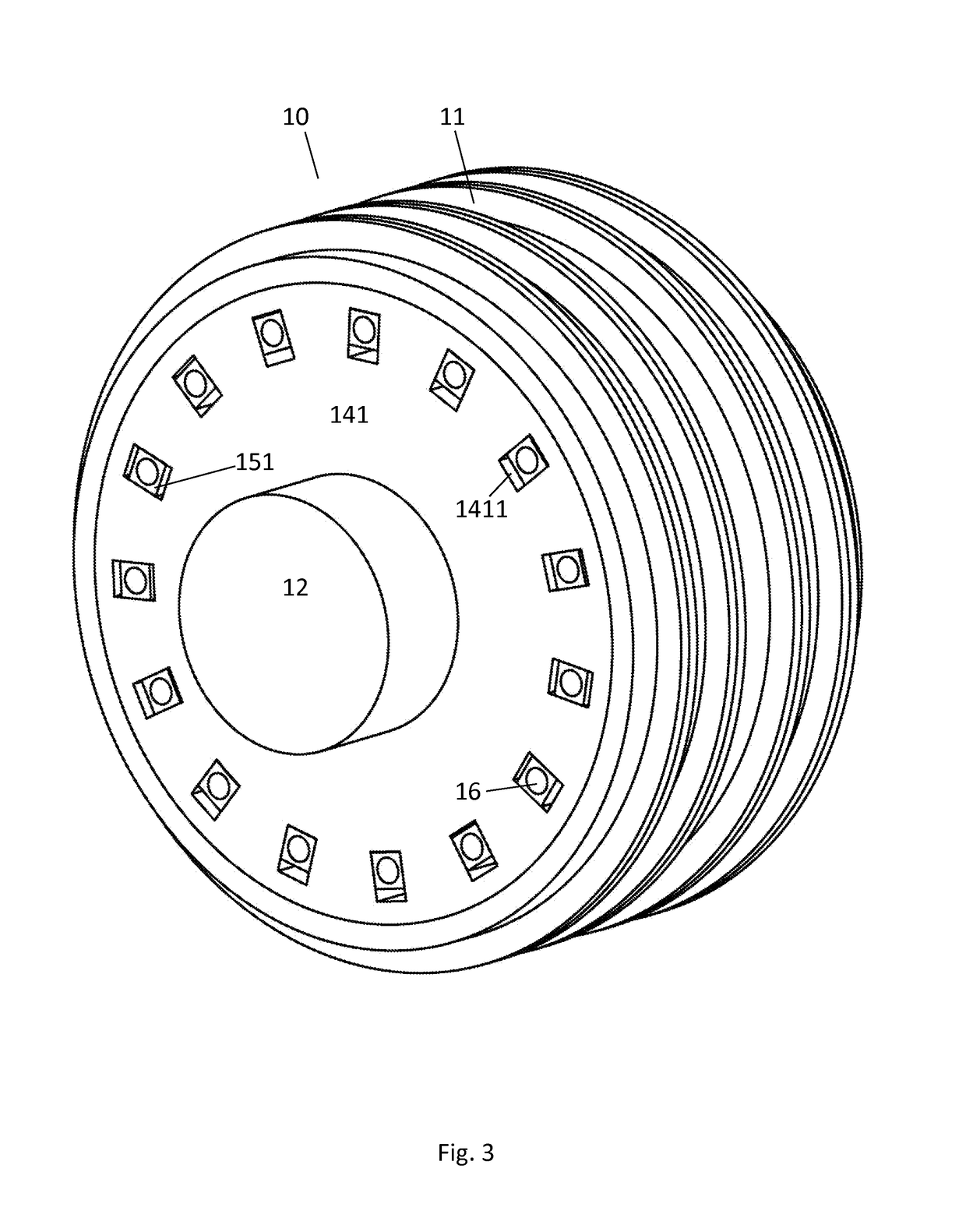Sliding friction-free gear
a friction-free gear and sliding technology, applied in the field of gears, can solve the problems of reducing durability and efficiency, complicated and expensive, and affecting the reliability of the gear,
- Summary
- Abstract
- Description
- Claims
- Application Information
AI Technical Summary
Benefits of technology
Problems solved by technology
Method used
Image
Examples
first embodiment
, Variant a (FIGS. 1-15)
[0086]A gear 10 according to the present invention, being the first preferred embodiment of the invention (see FIGS. 1-17, and particularly FIGS. 1-15), has a body 11, an input shaft 12, an output shaft 13, and a roller's yoke 14 (FIGS. 1, 2). Body 11 is composed of five parts 111, 112, 113, 114, and 115 joined by screws (not shown) or in any other suitable manner (FIGS. 1, 2, 3, 4, 7, 8). Input shaft 12 is supported pivotally in body part 111; output shaft 13 is supported pivotally in body part 115, coaxially with the input shaft 12 (FIGS. 2, 7, 8). Output shaft 13 has a disc 131 fastened thereon (FIGS. 2, 7, 11). Roller's yoke 14 is fastened with the help of screws (not shown), or in any other suitable manner, to the disc 113. Roller's yoke 14 is composed of two principal elements 141, and 145, and three intermediate elements 142, 143, 144, connected together by screws (not shown), or in any other suitable manner (FIGS. 7, 8, and particularly FIGS. 11, 12, ...
second embodiment (figs.18-23)
Second Embodiment (FIGS. 18-23)
[0092]The second embodiment of the gear according to the present invention differs from the first embodiment by the method of connecting the rollers with output shaft 13. This circumstance forces other profiles of cams, but renders the roller's yoke unnecessary.
[0093]Gear 10 being the second embodiment of the present invention (FIGS. 18-23) has a body 11, input shaft 12, output shaft 13, and a plurality (in this example 9) of roller assemblies 161-162-17-18-19. Body 11 (FIGS. 18-20 and 22) is composed of four parts 111, 112, 113, and 114. Placed in part 112 of body 11 there is cam 1121 with a number (10 in this example) of lobes; thus the number of lobes is greater by one than the number of roller assemblies, so output shaft 13 and input shaft 12 rotate in mutually opposite directions, and the transmission ratio of the gear equals −n, where n is the number of roller assemblies (thus in this example the transmission ratio equals −9). Input shaft 12 is m...
third embodiment (figs.24-33)
Third Embodiment (FIGS. 24-33)
[0096]The third preferred embodiment of the gear according to the instant invention differs from the first and the second embodiment in that cam 1121 placed in body 11 of the first and second embodiment is replaced by cam 132 placed on output shaft; this difference also forces a change in the method of mounting of roller assemblies, which in the present example are “stationary”, i.e. mounted directly in the gear body 11.
[0097]Thus gear 10 being the third embodiment of the invention has body 11, input shaft 12, output shaft 13, and a number n (in this example 9) of roller assemblies 21-22-23-161-162-163 (FIGS. 24-30). Input 12 and output 13 shafts are mounted pivotally and coaxially in body 11. Arranged in body 11 there are n sockets 116, in which semi-circular levers 23 of roller assemblies 21-22-23-161-162-163 are mounted pivotally (FIGS. 24-29, and particularly FIG. 28). Input shaft has cam (in this example an eccentric) 121 placed thereon. Output sha...
PUM
 Login to View More
Login to View More Abstract
Description
Claims
Application Information
 Login to View More
Login to View More - R&D
- Intellectual Property
- Life Sciences
- Materials
- Tech Scout
- Unparalleled Data Quality
- Higher Quality Content
- 60% Fewer Hallucinations
Browse by: Latest US Patents, China's latest patents, Technical Efficacy Thesaurus, Application Domain, Technology Topic, Popular Technical Reports.
© 2025 PatSnap. All rights reserved.Legal|Privacy policy|Modern Slavery Act Transparency Statement|Sitemap|About US| Contact US: help@patsnap.com



